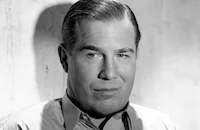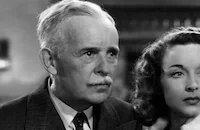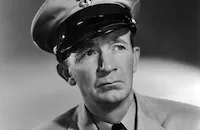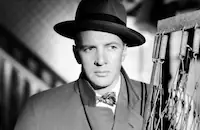Death on the Diamond

Brief Synopsis
Cast & Crew
Edward Sedgwick
Robert Young
Madge Evans
Nat Pendleton
Ted Healy
C. Henry Gordon
Film Details
Technical Specs

Synopsis
At the start of spring training, major league baseball manager and owner Pop Clark brings Larry Kelly, a highly promising young pitcher from the Texas league, to his struggling St. Louis Cardinal team. After chasing off two former players who were kicked off the team for gambling, Pop confides in his daughter Frances, the team's secretary, that if the Cardinals fail to win the pennant, he will lose the franchise to greedy business rival Henry Ainsley. That night, Larry is befriended by the wealthy Joseph Karnes, but is advised by veteran sports reporter Jimmie Downey that Karnes is a notorious gambler. After Mickey, the ballboy, discovers two men tampering with the pitchers' mitts, the team physician announces that the mitts had been covered with a serious skin-damaging substance. Slugger Dunk Spencer, who, like Jimmie, is infatuated with Frances, accuses Jimmie of sabotaging the mitts as a means of reducing his competition. Frances, however, dismisses Spencer's claims and forces the two men to bury their hostilities for the sake of the team. Although the Cardinals are given only twenty-to-one odds to win the pennant, they quickly climb to second place behind Larry's pitching and Spencer's hitting. Worried that he will lose one million dollars, Karnes, who bet against the Cardinals, tries to bribe Larry by leaving $10,000 on his hotel pillow. Larry, however, shows Pop and Jimmie the money, and the bribe attempt is made public. Later, a taxi carrying Larry and his hotdog-loving teammate, Truck Hogan, is shot at and crashes. In the accident, Larry suffers a foot injury that forces him out of the game for two weeks. While Larry is recuperating, the Cardinals move into first place and need to win only two out of three games to clinch the pennant. During the first crucial game in Chicago, Spencer is shot and killed by a gunman in the stadium as he is about to score the winning run. Because of his rivalry with Spencer, Jimmie is questioned by the police but is not charged. Just before the second game, pitcher Frank Higgins is called to the telephone and, in spite of tight security overseen by groundskeeper and former Cardinal player Patterson, is strangled in the locker room. After Truck leads the Cardinals to victory, one of his hotdogs is laced with poison, and he dies before identifying the killer to police. Although the police want to cancel the last game with the Cincinnati Reds, Pop insists on playing and slates Larry to pitch. When Frances confesses to Pop that she loves Larry, Pop starts to pull him from the lineup but is persuaded by Jimmie, who wants to trap the murderer, to keep his star in the game. During the game, Larry sees someone in the dugout placing an explosive in his warm-up jacket and hurls his baseball at the saboteur's head. After the explosive is safely detonated, the killer is revealed to be Patterson, whose anger at being hired by Pop as a groundskeeper instead of a coach, drove him to conspire with Ainsley to ruin the Cardinals. The mystery solved, Larry slugs the game-winning hit and embraces Frances, his bride-to-be.

Director

Edward Sedgwick
Cast

Robert Young

Madge Evans

Nat Pendleton

Ted Healy

C. Henry Gordon

Paul Kelly

David Landau

Dewitt Jennings

Edward Brophy
Willard Robertson

Mickey Rooney
Robert Livingston

Joe Sauers

James Ellison
Ray Mayer
Pat Flaherty
Ralph Bushman
Charles Sullivan
Tom Mcguire
Hector Sarno
Carl Stockdale
Pat O'malley

Howard C. Hickman

Lee Phelps
James Farley

Walter Brennan
Heinie Conklin
Max Wagner
John Hyams
Fred "snowflake" Toones
Bert Lindley

Ward Bond
Allen Wood
Alice Lake
Frank Marlowe
Sherry Hall
Garry Owen
Jules Cowles
James C. Morton
Billy Watson
Gertrude Short
Ernie Alexander
Eddie Dunn
Walter Clinton
Wilbur Mack
Albert Richman
Larry Steers
Baldwin Cook
Les Goodwins
Marc Lawrence
Kane Richmond
Frank Layton

Herman Brix
Don Brodie
Sumner Getchell
Jack Raymond
Brooks Benedict
Ed Philips
William Griffith
Louis Natheaux
Crew
Ray Binger
Gavin Burns
Cedric Gibbons
Lucien Hubbard
Milton Krasner
Douglas Shearer
Joe Sherman
Leonard Smith
Ralph Spence
Frank Sullivan
Harvey Thew
David Townsend
John Waters
Edward Woehler

Videos
Movie Clip


Film Details
Technical Specs

Articles
Death on the Diamond
I could be talking about the 2010 Washington Nationals and Steven Strasburg, but this isn't the sports pages. What we have before us here is Death on the Diamond, a 1934 B-movie mystery starring Robert Young. As baseball movies go, this is distinguished by some convincing visual touches: the team in question is no generic fiction, but is said to be the St. Louis Cardinals. The real team logo is used, and second-unit director John Waters actually went to St. Louis with cameramen Ray Binger and Leonard Smith to shoot some footage of the stadium and fans for both this and an additional baseball picture then in production, the short Donkey Baseball (love that efficient B-movie work ethic!). Actual players from the Cards, the Cubs, and the Cincinnati Reds populate the film, and former Giants pitcher-turned-Hollywood consultant Pat Flaherty has a minor role.
It's just window dressing. Movies like The Natural (1984) or Field of Dreams (1989) try to explore what baseball means to American culture; movies like Bull Durham (1988) or 2008's Sugar immerse themselves in the milieu to depict what baseball life is really like. Death on the Diamond exploits the trappings of baseball to lend some distinctive attributes to an otherwise conventional crime melodrama. The plot revolves around the idea that "Pop Clark" (David Landau) stands to lose the Cardinals franchise if he doesn't win the pennant--while the idea of a family-owned business or farm facing the threat of foreclosure is one of the oldest plots in the book. The various jealousies and rivalries that complicate the murder mystery could be transposed to just about any non-baseball setting intact.
The movie doesn't even follow its own nutty logic of how baseball is supposed to work. We are asked to accept that the team's chances hinge entirely on the success of star pitcher Larry Kelly (Robert Young). A mysterious assassin engineers a car wreck that lays Kelly up for a couple of weeks in rehab--and again, the entire point of this development is that without Kelly the team is supposed to be hobbled. Returning to the real-life parallel of the Washington Nats mentioned above, when Strasburg was put out of the game for Tommy John surgery, his absence did hobble the team's long-term prospects. Although the Nats line-up included a number of extraordinary players including past Golden Glove winners and almost-certain-to-be-future Hall of Famers, just one player's disappearance suddenly obliged the team's management to take cold, hard looks at whether it even made sense to pay the salaries of certain expensive hitters, on the premise the Nats could not expect to be in contention without Strasburg. With that context in mind, let's return to Death on the Diamond, already in progress: the Cardinals keep on winning without Kelly. So the mysterious villain must strike again, and again: he kills the team's best hitter, then kills another pitcher, then kills the catcher! Forget whether injuring Kelly should have had some significant consequence, we have here a team that in the span of a few days has seen three of its players murdered! The police investigation brings out in the open all manner of interpersonal conflicts and suspicions, not to mention the ever-present worry about which player will be targeted next (and did I mention the bomb in the dugout, or the pitchers' mitts coated with acid?) In real-life, when the Detroit Tigers lost announcer Ernie Harwell to cancer, it was a devastating blow that left a pall over the entire season. In the world of this movie, no one stops to grieve the dead, and the domino-like procession of murdered players does nothing to impede the Cardinals' stampede towards victory.
In another curious development, gangsters try to bribe Kelly into throwing a game. They do so very publicly, leaving a stack of bills on his bed with a note. The $10,000 is a paltry sum by modern standards, and when his teammates remark "That's sure a heap of money for a ballplayer," it's hard not to laugh. By the standards of 1934 it was a meaningful amount, though, and it provokes an interesting dilemma. Kelly takes the money to the front office, and they in turn reveal it to the press. This honest move puts Kelly in a tough spot, though. His fans can't be sure whether the $10 grand he turned in was the entire sum offered, and if he fails to win the next game it may look like he failed on purpose. "Now I gotta win!" he exclaims--as if winning and losing was purely the result of proper motivation.
That is not to say this modest little movie does not have its share of minor triumphs. As illogical as the plot may be, it is marked by several nice moments. Director Edward Sedgwick was a contract director for MGM who had worked his way up from B-Westerns and cliffhanger serials to what was at the time a choice gig working with Buster Keaton. The partnership with Keaton turned sour, partly to do with Keaton's estrangement from MGM and the poor quality of scripts assigned to him. To judge Sedgwick by his work with Keaton is perhaps unfair, and in Death on the Diamond Sedgwick brings a stylistic flair missing from his slapstick comedies. Perhaps the baseball setting appealed to him especially--Sedgwick's silent days included a number of baseball-themed programs, like Hit and Run (1924) and Slide, Kelly, Slide (1927). Robert Young was still a newbie to the movie business, having made his first screen test just three years previously. In the course of those three years he appeared in a staggering twenty-two movies already (there's that B-movie work ethic for you again). The upshot of such an intense on-the-job education is that Young was developing a natural comfort in front of the camera that would propel him into leading man status in the years to come. In one scene, the Cardinals players happen upon an un-self-conscious Kelly practicing his windup in front of a mirror. He's dressed for a date, and caught awkwardly between getting ready for a night on the town and working out some technical quirk in his mechanics. Young's performance of this quiet scene is a delight. He was a late addition to the cast, replacing Franchot Tone in the Kelly role, and his scenes on the mound are all obvious process shots with Young in front of a grainy back-projection screen, but this one little moment in front of a hotel room mirror goes a long way to convincing the audience that Robert Young is an actual baseball pitcher.
One more small triumph needs to be called out here--Ted Healy, the vaudeville comedian who founded the Three Stooges, plays the Cardinals' home plate umpire. Or "empire," as the running gag between him and catcher Truck Hogan (Nat Pendleton) has it. Throughout the film, Sedgwick uses Healy and Pendleton's double-act as comic relief. You half expect Healy and Pendleton to launch into their own version of "Who's On First." When Pendleton's character is killed, the police immediately turn to Healy as a likely suspect, since the two were known to argue constantly and threaten violence to each other as a matter of routine. And then, in that moment, Healy delivers a heart-rending and beautifully underplayed eulogy to his dead friend. In a few lines of dialogue, almost whispered, Healy not only acquits himself of any suspicion, but he delivers the only moment of genuine emotion anywhere in the film.
Healy and Pendleton made a good pair. Both had comic gifts. Because the Three Stooges became ubiquitous television mainstays in films they made after splitting with Healy, his contribution to comedy film history tends to be underrepresented. Pendleton had better fortune, playing foil to the likes of Abbott and Costello and the Marx Brothers, and playing the big dumb lug role in countless 30s-era classics.
The cast of Death on the Diamond also includes such familiar faces as Walter Brennan. You might best remember this crusty little character actor as Stumpy in Howard Hawk's Rio Bravo (1959), and fans of baseball movies will remember him as Lou Gehrig's pal in The Pride of the Yankees (1942). Here he plays a hotdog vendor. Francis X. Bushman was a former silent-era star from the days of D.W. Griffith who kept busy as the world of movies changed around him. He literally left an enduring legacy in Hollywood--Sid Grauman's fabled Chinese Palace was built on Bushman's land. One of Bushman's last ever performances was as a silent-era movie buff, in TV's Batman. Also making a minor appearance is Mickey Rooney, one of the most tenacious performers in the history of the film industry. By the time he was cast as a batboy in Death on the Diamond, Mickey had already starred in no less than fifty short comedies, changed his name from McGuire to Rooney, and started moving from studio to studio to chase notable character parts. In other words, he was a kid with a lifetime's achievement already under his belt. A few years after this film he would play "Andy Hardy" for the first time, a role he would reprise over fifteen subsequent pictures. Madge Evans, the leading lady, was a former child-star whose brief run as a top-billed actress in the late 30s and 40s was competent if largely unremarkable.
In the 1940s, filmmakers largely abandoned the whodunit form for an approach to crime thrillers that emphasized character psychology and grim suspense. Those film noirs (or films noir, for those of you eating Whoppers Junior while you read this) tended to age more gracefully, and reward multiple viewings better than the routine programmers like Death on the Diamond that preceded them. Meanwhile, baseball matured as a business, leaving behind these relics of a whites-only sport where $10,000 could be an unheard-of fortune for a ballplayer. Death on the Diamond is a pleasant diversion, bound by rules and often predictable, but home to unexpected if fleeting moments of brilliance--not unlike the game of baseball itself.
Producer: Lucien Hubbard
Director: Edward Sedgwick
Screenplay: Harvey Thew, Joe Sherman, Ralph Spence; Cortland Fitzsimmons (book)
Cinematography: Milton Krasner
Art Direction: Cedric Gibbons
Music: William Axt (uncredited)
Film Editing: Frank Sullivan
Cast: Robert Young (Larry Kelly), Madge Evans (Frances Clark), Nat Pendleton ('Truck' Hogan), Ted Healy (Terrence 'Terry'/'Crawfish' O'Toole), C. Henry Gordon (Joseph 'Joe' Karnes), Paul Kelly (Jimmie Downey, reporter), David Landau (Pop Clark, manager), DeWitt Jennings (Mr. Patterson, groundskeeper), Edward Brophy (Police Sgt. Grogan), Willard Robertson (Police Lt Luke Cato), Mickey Rooney (Mickey), Robert Livingston (Frank 'Higgie' Higgins), Joe Sauers (Duncan 'Dunk' Spencer).
BW-71m.
by David Kalat
Sources:
Hal Erickson, Baseball in the Movies: A Comprehensive Reference, 1915-1991.
Variety September 25, 1934.

Death on the Diamond
Marc Lawrence (1910-2005)
Born Max Goldsmith on February 17, 1910, in the Bronx, Lawrence had his heart set on a career in drama right out of high school. He enrolled at City College of New York to study theatre, and in 1930, he worked under famed stage actress Eva Le Gallienne. Anxious for a career in movies, Lawrence moved to Hollywood in 1932 and found work immediately as a contract player with Warner Bros. (an ideal studio for the actor since they specialized in crime dramas). He was cast as a heavy in his first film, If I Had a Million (1932). Although his first few parts were uncredited, Lawrence's roles grew more prominent: a sinister henchman in the Paul Muni vehicle in Dr. Socrates (1935); a conniving convict aiding Pat O'Brien in San Quentin (1937); a menacing thug stalking Dorothy Lamour in Johnny Apollo (1940); the shrewdly observant chauffeur in Alan Ladd's breakthrough hit This Gun For Hire (1942); and one of his most memorable roles as Ziggy, a fedora wearing mobster in the Bogart-Bacall noir classic Key Largo (1948).
Lawrence, when given the opportunity, could play against type: as the prosecuting attorney challenging Tyrone Power in Brigham Young (1940); a noble aristocrat in the Greer Garson-Walter Pidgeon period opus Blossoms in the Dust; and most impressively, as a deaf mute simpleton in the rustic drama The Shepherd of the Hills (both 1941). Better still was Lawrence's skill at comedy, where his deadpan toughness worked terrifically as a straight man against the likes of Joe E. Brown in Beware Spooks (1939); Abbott and Costello in Hit the Ice (1943); Penny Singleton in Life with Blondie (1945); and Bob Hope in My Favorite Spy (1951).
After that, Lawrence's career took a turn downward spin when he was labeled a communist sympathizer during the Hollywood witch hunts of the early '50s. He was exiled in Europe for a spell (1951-59), and when he came back, the film industry turned a blind eye to him, but television overcompensated for that. Here he played effective villains (what else?) in a series of crime caper programs: Peter Gunn, Johnny Staccato, The Untouchables, Richard Diamond, Private Detective; and eventually made a welcome return to the big screen as a returning exiled gangster in William Asher's underrated mob thriller Johnny Cool (1963).
It wasn't long before Lawrence found himself back in the fray playing in some big box-office hits over the next two decades: Diamonds Are Forever (1971), The Man with the Golden Gun (1974), Marathon Man (1976), Foul Play (1978); and The Big Easy (1987). Sure he was cast as a gangster, but nobody could play a rough and tumble mob boss with more style or conviction.
Interestingly, one of his finest performances in recent years was in television, as a severely ill old man unwilling to accept his fate in a fourth season episode of ER (1997-98). His last screen role was just two years ago, as a nimble minded VP in Looney Tunes: Back in Action (2003).
In 1991, Lawrence published a memoir about his venerable career, Long Time No See: Confessions of a Hollywood Gangster that received much critical acclaim. He has also developed a cult following due to his appearances in such offbeat items as From Dusk to Dawn and Pigs aka Daddy's Deadly Darling, the 1972 horror film he directed and starred in with his daughter Toni. He is survived by his wife, Alicia; two children from a previous marriage, Toni and Michael; and a stepdaughter Marina.
by Michael T. Toole
Marc Lawrence (1910-2005)
Quotes
Trivia
Franchot Tone was initially cast in the role of "Larry" but was replaced by 'Young, Robert' prior to the start of production.
Several old time baseball players were supposedly cast in the movie.
Notes
Franchot Tone was first assigned to the role of "Larry" but was replaced by Robert Young prior to production. Motion Picture Herald's "The Cutting Room" noted that "several oldtime ball players and the present St. Louis and Chicago National League ball clubs" were cast in the film. Pat Flaherty, who plays a coach in the film, was a former New York Giants pitcher. Hollywood Reporter production charts add Jim Donlan, Jules Besco, Charles Wilson, Ben Hendricks, Fred Graham and Al Hill to the cast, but their participation in the final film has not been confirmed. In addition, Hollywood Reporter production charts list Bobs Watson as a cast member. However, the CBCS lists only Bobs's lookalike brother Billy as a bit player. According to an June 18, 1934 Hollywood Reporter news item, John Waters, an M-G-M special unit director, went to St. Louis to make baseball diamond and grandstand background shots for this film and another unspecified production. Waters was accompanied by cameraman Ray Binger, who was met by Leonard Smith, another M-G-M photographer.














